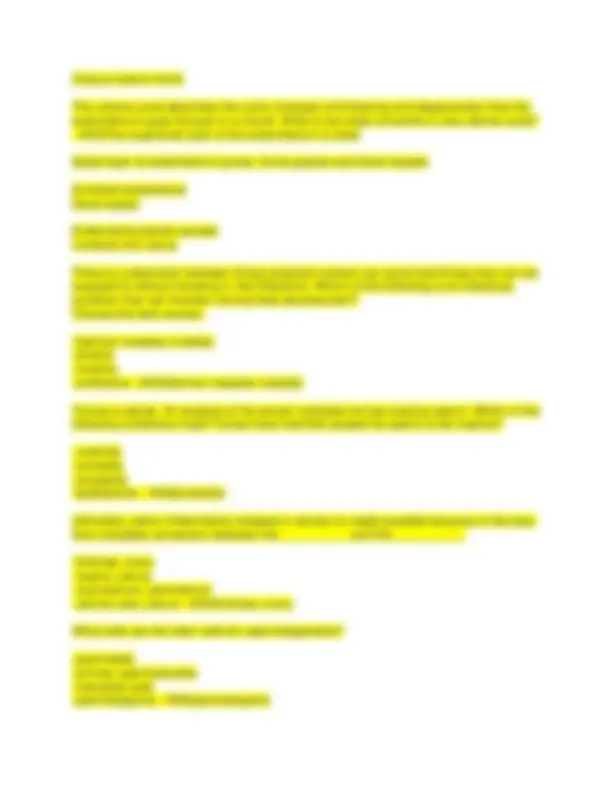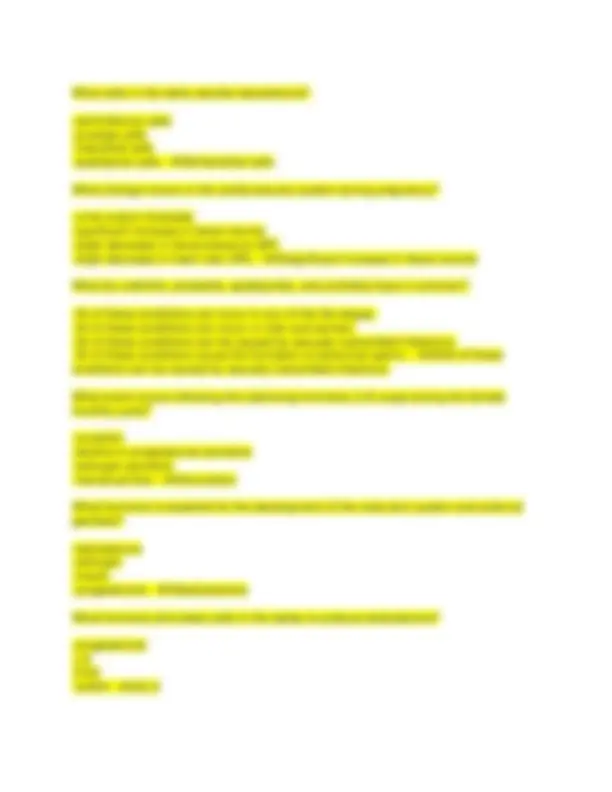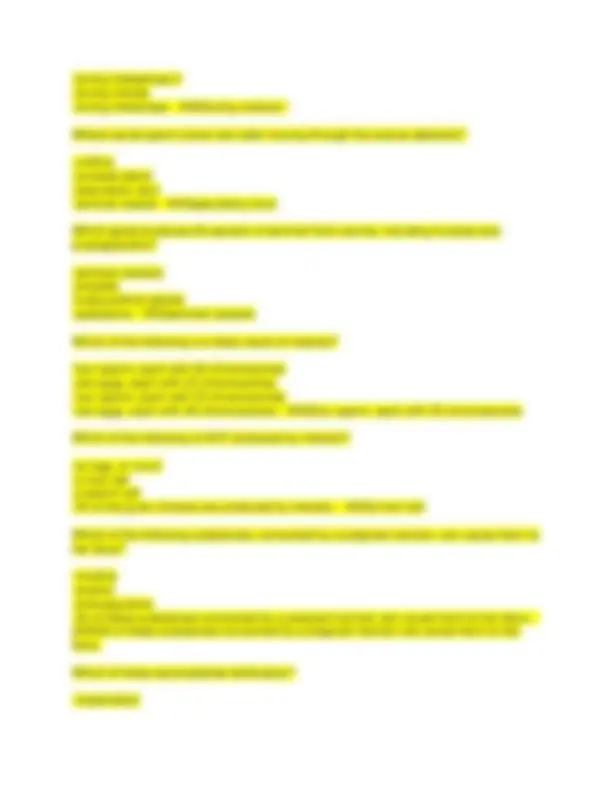







Study with the several resources on Docsity

Earn points by helping other students or get them with a premium plan


Prepare for your exams
Study with the several resources on Docsity

Earn points to download
Earn points by helping other students or get them with a premium plan
Community
Ask the community for help and clear up your study doubts
Discover the best universities in your country according to Docsity users
Free resources
Download our free guides on studying techniques, anxiety management strategies, and thesis advice from Docsity tutors
Essentials of Human Anatomy & Physiology (11) Activity Lab 16. 2025 Questions & Verified Answers. Graded A+..pdf
Typology: Exams
1 / 9

This page cannot be seen from the preview
Don't miss anything!






After DNA replication, each individual chromosome becomes a homologous pair. True False - ANSFalse An XY person whose cells did not respond to the effects of androgens (a condition called complete androgen insensitivity) would look anatomically like a __________. female male hermaphrodite male, female, or hermaphrodite - ANSfemale Antonin has a mitochondrial disease that is affecting sperm functioning. What specific sperm function is being affected? spermatic meiosis sperm motility egg penetration spermatic mitosis - ANSsperm motility Bob was born with a tumor in his anterior pituitary. Among other problems, he did not development secondary sex characteristics and his reproductive organs did not develop normally. Bob is also sterile. The lack of which hormone is responsible for Bob's condition? GnRH FSH LH The lack of any one of these hormones or all of them could have caused Bob's symptoms. - ANSLH Boris has to strain to urinate and has cystitis. Which of Boris's reproductive structures is the underlying cause of his problems? epididymis prostate testicles penile urethra - ANSprostate
Cervical cancer is localized between what two structures? fimbriae and ovary uterine tube and uterus vagina and fundus endometrium and myometrium - ANSvagina and fundus Chromosomes can exchange genetic information during a process called "crossing over." This occurs when homologous chromosomes are lined up in pairs. When does this happen? anaphase II metaphase I metaphase II anaphase I - ANSmetaphase I Fig 16.1 - ANS Fig 16.2 - ANS Fig 16.8 - ANS Fig 16.9 - ANS Fig 16.13 - ANS How does pregnancy change the functioning of the mother's body? Select all the correct statements. Many women develop an accentuated sacral curvature. A woman has a higher blood volume and cardiac output during pregnancy. The rib cage becomes longer and narrower during pregnancy. The uterus presses on the urinary bladder, causing stress incontinence. The hormone relaxin helps widen the pelvic girdle. - ANSA woman has a higher blood volume and cardiac output during pregnancy. The uterus presses on the urinary bladder, causing stress incontinence. The hormone relaxin helps widen the pelvic girdle. In what part of the female reproductive tract does fertilization typically occur? uterine (Fallopian) tube vagina uterus
Corpus luteum forms The uterine cycle describes the cyclic changes of thickening and degeneration that the endometrium goes through in a month. What is the order of events in one uterine cycle?
What cells in the testis secrete testosterone? seminiferous cells prostate cells interstitial cells epididymal cells - ANSinterstitial cells What change occurs in the cardiovascular system during pregnancy? urine output increases significant increase in blood volume slight decrease in blood pressure (BP) slight decrease in heart rate (HR) - ANSsignificant increase in blood volume What do urethritis, prostatitis, epididymitis, and orchiditis have in common? All of these conditions can occur in any of the life stages. All of these conditions can occur in men and women. All of these conditions can be caused by sexually transmitted infections. All of these conditions cause the formation of abnormal sperm. - ANSAll of these conditions can be caused by sexually transmitted infections. What event occurs following the luteinizing hormone (LH) surge during the female monthly cycle? ovulation decline in progesterone secretion estrogen secretion menstrual flow - ANSovulation What hormone is essential for the development of the male duct system and external genitalia? testosterone estrogen insulin progesterone - ANStestosterone What hormone stimulates cells in the testes to produce testosterone? progesterone LH FSH GnRH - ANSLH
ovary vagina vulva uterus - ANSovary What part of the male reproductive system conducts both semen and urine? urethra ductus deferens ejaculatory duct epididymis - ANSurethra What part of the uterus projects into the vagina? cervix fundus endometrium body - ANScervix What semen-producing glands are found on the posterior surface of the urinary bladder? prostate glands bulbourethral glands seminal vesicles epididymis - ANSseminal vesicles What structure takes over the endocrine function of the corpus luteum? placenta chorion trophoblast amnion - ANSplacenta What term refers to the lining of the uterus? endothelium endometrium myometrium perimetrium - ANSendometrium When does the total number of chromosomes get reduced from 46 pairs to 23 individual chromosomes? during meiosis I
during metaphase II during mitosis during interphase - ANSduring meiosis I Where would sperm travel next after moving through the ductus deferens? urethra prostate gland ejaculatory duct seminal vesicle - ANSejaculatory duct Which gland produces 60 percent of seminal fluid volume, including fructose and prostaglandins? seminal vesicles prostate bulbourethral glands epididymis - ANSseminal vesicles Which of the following is a likely result of meiosis? four sperm, each with 46 chromosomes two eggs, each with 23 chromosomes four sperm, each with 23 chromosomes two eggs, each with 46 chromosomes - ANSfour sperm, each with 23 chromosomes Which of the following is NOT produced by meiosis? an egg, or ovum a liver cell a sperm cell All of the given choices are produced by meiosis. - ANSa liver cell Which of the following substances, consumed by a pregnant woman, can cause harm to her fetus? nicotine alcohol anticoagulants All of these substances consumed by a pregnant woman can cause harm to her fetus. - ANSAll of these substances consumed by a pregnant woman can cause harm to her fetus. Which of these accomplishes fertilization? implantation